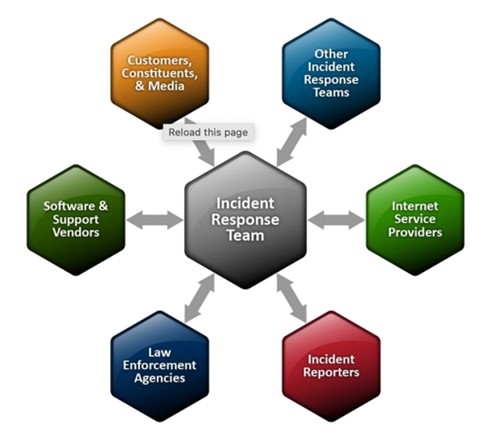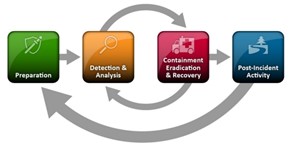As everyone looks about, sirens begin to sound, creating a sense of urgency; they only have a split second to determine what to do next. The announcer repeats himself over the loudspeaker in short bursts... This is not a drill; report to your individual formations and proceed to the allocated zone by following the numbers on your squad leader's red cap. I take a breather and contemplate whether this is an evacuation. What underlying danger is entering our daily activities? 1…2….3…. Let's get this party started!
When I come to… I find that the blue and red lights only exist in the security operations center. Intruders are attempting to infiltrate our defenses in real time; therefore, we are on high alert. The time has come to rely on incident response plans, disaster recovery procedures, and business continuity plans. We serve as security posture guardians and incident response strategy executors as organizational security leaders. It is vital to respond to and mitigate cyber incidents, as well as to reduce security, financial, legal, and organizational risks in an efficient and effective manner.
Stakeholder community
CISOs, as security leaders, must develop incident response teams to combat cybercrime, data theft, and service failures, which jeopardize daily operations and prevent consumers from receiving world-class service. To maintain operations pace, alert the on-the-ground, first-line-of-defense engagement teams, and stimulate real-time decision-making, Incident Response Plan (IRP) protocols must include end-to-end, diverse communication channels.
What does an incident response plan (IRP) do?
That's an excellent question. The incident response plan gives a structure or guideline to follow to reduce, mitigate, and recover from a data breach or attack. Such attacks have the potential to cause chaos by impacting customers, stealing sensitive data or intellectual property, and damaging brand value. The important steps of the incident response process, according to the National Institute of Standards and Technology (NIST), are preparation, detection and analysis, containment, eradication, and recovery, and post-incident activity that focuses on a continual learning and improvement cycle.
Lifecycle of Incident Response
Many company leaders confront a bottleneck when it comes to assigning a severity rating that determines the impact of the incident and establishes the framework for resolution strategies and external messaging. For some firms, being able to inspect the damage and appropriately assign a priority level and impact rating can be stressful and terrifying.
Rating events can help prioritize limited resources. The incident's business impact is calculated by combining the functional effect on the organization's systems and the impact on the organization's information. The recoverability of the situation dictates the possible answers that the team may take while dealing with the issue. A high functional impact occurrence with a low recovery effort is suited for fast team action.
The heart beat
Companies should follow industry standards that have been tried and tested by fire departments to improve overall incident response effectiveness. This includes:
- Current contact lists, on-call schedules/rotations for SMEs, and backups
- Conferencing tools (e.g., distribution lists, Slack channels, emails, phone numbers)
- Technical documentation, network diagrams, and accompanying plans/runbooks
- Escalation processes for inaccessible SMEs
Since enemies are moving their emphasis away from established pathways to avoid defenders, it is vital to enlist third-party threat landscape evaluations. These can halt the bleeding and cauterize the wound, much like a surgeon in a high-stress operation. Threat actors are always improving their abilities using the same emerging sizzling cyber technologies that defenders use.
Despite widespread recognition of the human aspect as the weakest link, threat actors study their prey's network to seek alternative weak points such as straddle vulnerability exploitation and credential theft. Employ Managed Threat Detection Response (MTDR), Threat Model Workshop (TMW), and Cyber Risk Posture Assessment (CRPA) services to expertly manage your infrastructure and cloud environments in a one-size-fits-all way.
Takeaways
Take inventory of your assets
- Increase return on investment
- Provide comprehensive coverage
- Accelerate compliance needs
- Create a cybersecurity monitoring response strategy
- Emphasize essential resources, attack surface area, and threat vectors
- Deliver transparent, seamless security
Elevate security ecosystem
- Improve the efficiency and effectiveness of incident response systems.
- The Cyber Risk Posture Assessment (CRPA) encourages better decision-making in order to assess governance security posture.
- The Cyber Risk Posture Assessment (CRPA) & Threat Model Workshop (TMW) provide a method for evaluating the security attack surface and threat vectors.
- The Managed Threat Detection Response (MTDR) expands the security team's capabilities and competencies.
- Use scenario-based tabletop exercises and incident response planning exercises.
In the future, businesses should implement an incident response strategy, a collection of well-known, verified best practices, and assess their actual versus realized assets and security attack surface portfolio. Is your organization crisis-ready? A strong incident management solution increases organizational resiliency and continuity of operations in the event of a crisis.

